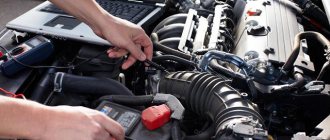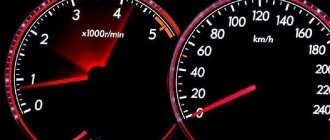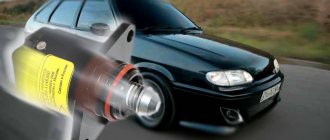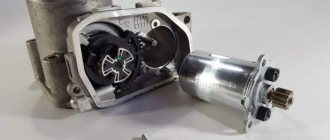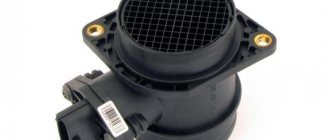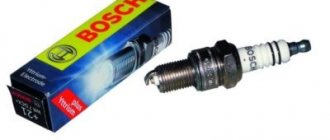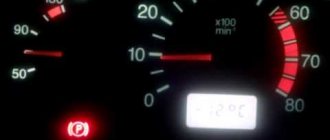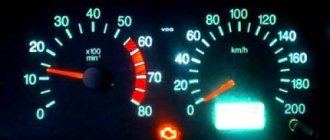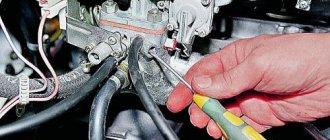Very often, people face the problem of idling in their car and constantly ask questions, why does the car stall at idle? The reasons can be very different: the car stalls at idle, the idle speed floats and swings, the engine is unstable at idle, the engine stalls. No need to immediately run to the store and buy an idle speed sensor! If you read the article to the end, you will probably understand all the intricacies and problems associated with idle speed.
In this article we will analyze in detail the most common car malfunctions related to idle speed. As you know, the engines of injection internal combustion cars are all built according to the same principle, be it a foreign car or a Russian Lada. If your car has poor idle speed, then this article will help you find the problem associated with poor engine idle speed almost 100%.
Let's look at the most common malfunctions that occur most often in practice associated with the causes of rough idling.
Air leaks in a car engine.
Air leaks in a car's internal combustion engine are a very common and widespread problem. How to check the engine for air leaks? There are special smoke generators for this, but you must admit, not everyone has them, and not every service station. The principle of operation of the smoke generator is to force smoke into the intake tract of the car engine manifold. To do this, the air filter is removed and through the hole through which the engine sucks air from the filter, a portion of smoke is supplied under low pressure. The result of this procedure is the fastest and most accurate for checking the presence of air leaks in a car engine. If there is a leak somewhere, a stream of smoke will appear from there.
But what to do if you don’t have a smoke generator at hand? You can use a syringe with gasoline or a can of WD-40. Start the engine and leave it idling. Take a can of WD-40 and spray it into possible air leaks. At the same time, do not forget about safety, because this liquid can ignite (in my practice this did not happen). If liquid gets into the source of air leakage, you will immediately notice changes in the engine's idle speed. The main places where air leaks in a car engine are.
- Intake manifold gaskets and O-rings.
- O-rings and rubber bands for fuel injectors.
- O-rings and rubber bands for the idle speed sensor.
- O-rings and rubber bands for the absolute pressure sensor (MAP).
- Tubes and hoses going from the intake manifold to the adsorber valve and also to the crankcase ventilation.
- Remove the pipe going to the vacuum brake booster and plug the hole going into the intake manifold. There have been cases when air leaks occurred through a broken diaphragm of the vacuum booster.
When performing the above steps, if the culprit is among them, you will immediately see changes in the engine’s idle speed; the idle speed should level out significantly.
There is another sure and simple way to check for air leaks in a car. To do this you need to use diagnostic equipment. The diagnostic program parameters will most likely contain the “Lean mixture” error. And in the parameters of the oxygen sensor (lambda probe), look at the first oxygen sensor before the catalyst (bank 1), if there is air leakage, it will have a low voltage. The oxygen sensor monitors the composition of the mixture in the exhaust manifold by measuring the presence of oxygen in the exhaust gases. The ideal mixture is considered to be 14.7 grams of air per gram of gasoline.
If you look at the graph, during normal engine operation the graph should look like a saw. Why on a saw? I'll tell you below. When the mixture is rich, the voltage at the oxygen sensor increases, and when it is lean, it drops. A narrowband sensor operates in the range from 0 volts to 1 volt, and a broadband oxygen sensor operates from 0 volts to 5 volts, which is why they have their names (UDK and ShDC). The broadband sensor measures a wide range and is used in more expensive cars. The SDK has five wires at the output and the UDC has four.
Now we read carefully, many auto electricians do not know this!
The operating algorithm of the oxygen sensor is as follows: the engine ECU deliberately enriches the mixture by changing the fuel injection time, while monitoring the readings from the oxygen sensor. As soon as the voltage at the oxygen sensor has increased to the maximum, the ECU understands that the mixture is rich, it immediately begins to forcefully lean the mixture by changing the injection downward and again monitors the readings of the oxygen sensor. As soon as the voltage drops to a minimum, the ECU realizes that the mixture is lean, it immediately begins to enrich it. Thus, during normal engine operation, the lambda probe readings on the diagnostic program graph look like a saw. This process is repeated constantly, which allows you to keep the mixture within normal limits in all ranges. All together this is called lambda regulation.
You will probably say now, what does the idle speed and the oxygen sensor have to do with it? I answer - the oxygen sensor has nothing to do with it! Just his readings will help you understand the state of the mixture. If there is an air leak on the car, then the readings on the oxygen sensor will always be in the poor range. Why in poor? You ask. Because the oxygen sensor measures the presence of oxygen in the exhaust and if there is air leakage in the intake, then the oxygen content in the exhaust will be above normal. You will now say, but the engine sucks in a large amount of air through the filter, and how can a small air leak affect this? When air passes through the filter, its quantity is measured by the mass air flow sensor and transmitted to the ECU. Accordingly, the air leak that comes from under the injector, or gasket, or anywhere else in the intake manifold is not taken into account by the ECU.
You can do an experiment. On a working car, force air into the manifold; you can remove any small rubber tube going into the manifold and you will immediately see how the voltage on the lambda umbrella drops to a minimum. I hope it is now clear what an important role lambda regulation plays in a car.
Cases from life! “AUTO ELECTRICIAN” calls me and asks: “Can you programmatically turn off the lambda probe?” I ask - Why is this necessary? “It doesn’t work,” says the electrician. In terms of? - I ask. Buy a new sensor and replace it. The electrician replies, “we already bought a new one and it doesn’t work either” (the oxygen sensor is not cheap). And what's the reason? - I ask. The computer gives an error, “Low voltage on the DC,” the electrician answers. Well, eliminate the air leak and everything will be back to normal - I answered and refused to flash the block.
The bottom line of this story is this. The electrician, due to his incompetence, burdened the client with replacing the lambda probe. Because there is an error in the oxygen sensor, “lean mixture” or “DC voltage is too low”. Naturally, the lambda probe did what it was supposed to do, it fulfilled its direct function. When the “miracle electrician” realized that replacing the sensor did not help, he sentenced the ECU to be castrated, with which he turned to me. Can you imagine how the client would have suffered after such an electrician! The man spent a lot of money, buying and replacing an oxygen sensor, flashing the ECU, plus. As a result, he paid money to have an electrician completely ruin his car, but the original fault remained the same, only a bunch of new problems appeared!
Okay, this is not what this article is about, let’s continue to search for the problem with the idle speed of the car. I think the topic of air leaks can be closed.
The principle of operation of an injection internal combustion engine
An injection engine is a more stable and economical system that does not require constant tuning. Instead of an unbalanced fuel-air mixture, which should be supplied to the power unit due to vacuum (but does not always do this), the cylinders began to receive a clearly dosed amount of fuel: it is supplied by a nozzle under pressure, and a corresponding amount of intake air is supplied to it.
A system with one nozzle in place of the carburetor is called mono-injection, but split injection is much more efficient.
Gasoline can be injected separately into each cylinder, just before the intake valve. Under a pressure of about 5 atmospheres, the fuel is crushed into fine dust; a carburetor with diffusers is not capable of achieving such a result. It has also become possible to increase the duration of cylinder purging: now it is carried out with air, and not with an air-fuel mixture, and gasoline does not literally fly out into the pipe.
It was possible to implement the technology due to the fact that the modes of the power unit began to be controlled by electronics, and the carburetor was controlled by vacuum.
In a diesel engine it is somewhat different: there the air is always supplied in full. Diesel fuel burns within a very wide range of ratios with air. And when using an injection system, you need to regulate the amount of fuel, air and the ratio between them (the ratio 14.7/1 is considered chemically ideal), this has significantly increased the number of sensors monitoring the current parameters.
The electronics of a modern injection engine receives data from sensors:
- detonation;
- oxygen;
- crankshaft position;
- camshaft position;
- speed;
- coolant temperature.
All information is transmitted to the electronic control unit (ECU), which controls the process. The electronic brain also took over control of the ignition timing (by the way, it prevents detonation, receiving a signal from the corresponding sensor ).
There is no compression in the engine cylinders.
Another very common cause of unstable idling and poor engine performance in general is insufficient compression in the engine cylinders. Compression must be measured using a special pressure gauge “Compressometer”. The compression in the engine cylinders should be on average 12 atm.
Attention! If the compression is below 8 atmospheres, the mixture in the cylinders at low speeds no longer ignites, which also affects engine idle speed, as well as fuel consumption and dynamics in general.
The reasons for poor compression most often lie in a faulty cylinder head (cylinder head) of the car engine. Exhaust valves can crack due to time and thermal stress.
Also, there may not be compression in two cylinders standing next to each other at once. The cause is a burnt cylinder head gasket between the cylinders. As a result, pressure is simply pumped from one cylinder to another. Most often, the main engine gasket burns out in the middle, usually between cylinders 3 and 4. Insufficient compression may also be due to improper valve adjustment. If the intake or exhaust valves do not have clearance and do not fit tightly to the cylinder head seats, then compression will also be weak. Problems most rarely occur with the piston group.
If the engine troits
If there is a clear problem: the car shakes steadily at regular intervals, as if falling on one leg, the reason should be sought in a separate cylinder :
- Using pliers with insulated handles, remove the high-voltage wires one by one - if the cylinder is faulty, there will be no reaction when the contact is disconnected.
- Next, you need to check the entire electrical circuit for this cylinder: after unscrewing the spark plug, look at what color it is, what it is filled with, what the gap is between the electrodes. An indicator of normal operation is the light brown color of the electrodes. If the mixture is rich, then it is black, and if it is white, then it is poor (both words starting with “B” are convenient to remember).
- But maybe it's not the electrician's fault. It is possible that while the engine is running, coolant enters the combustion chamber (the head gasket is broken), and if it is filled with oil, it is through the rings, crankcase ventilation or valve stem seals. They should also cause a bluish smoke when taking on a load (starting from a stop or changing gears). Oil can also leak through the gasket, but this is very rare.
You don’t need to start cleaning the spark plug right away; you should take a good look at it and find the root cause that is causing the engine to run unevenly. If you have an endoscope, it is good to look inside through the spark plug hole. Compression and valve adjustment also need to be checked.
The idle speed sensor is faulty.
If the fuel-injected car does not idle, or stalls at idle, and the speed also freezes when releasing the gas. The cause of the malfunction may be the idle speed sensor. (not applicable on vehicles with electronic throttle). There are two types of idle speed sensors, stepper and torque.
On domestic cars, stepper idle speed controllers (IAC) are mainly used; on foreign cars, both of them, both stepper and torque, are used. The idle air control controls the amount of air that enters through a special hole in the throttle assembly. When the vehicle is idling and the accelerator pedal is released and the throttle valve is closed, air enters the engine through the PXX valve. The car's ECU is programmed so that the engine speed is always in the same range, for example 850 rpm. If the speed deviates from the set value, the ECU will control the IAC sensor. For example, the engine speed exceeds the set value of 850 rpm, then the ECU will control the IAC valve, trying to reduce the cross-section of the air channel through which the engine breathes at idle. If the engine speed is less than the set value of 850 rpm, then the IAC valve will increase the cross-section of the air channel until the speed value is equal to the set value.
Checking the electro-pneumatic valve control unit.
You will find the control unit for the EPHH electro-pneumatic valve on the left mudguard in the engine compartment.
Gradually increase engine speed. At engine speeds of 1500–2000 rpm, the voltmeter readings will drop abruptly to 0.5–1.5 V or the warning light will go out.
We replace the faulty unit with a new one, for this...
4. ...disconnect the connector...
5. ...and use a screwdriver to unscrew the two screws securing the block to the mudguard. Next, we install the new EPHH block in reverse order.
How to check the idle air control.
When you turn off the engine, the idle air valve completely closes the air passage through which the engine receives air while idling. Accordingly, when you turn on the ignition before starting the engine, the idle air valve opens the cross-section of the air channel in order for the engine to start. At the same time, a characteristic buzzing sound is heard in the throttle valve area. Since the idle air control is essentially an electric motor. If you turn the ignition on and off without starting the engine, the idle speed control will move back and forth. This manual is not suitable for torque idle speed controllers, they operate silently.
You can also check the idle speed sensor using the diagnostic program. Any diagnostic program has a parameter - “Management of actuators”. We go to the program menu and find the parameter, “Idling control”. With the engine running, through the diagnostic program we try to change the position or steps of the idle speed control, while the engine speed should change in one direction or another. If the IAC is controlled through the diagnostic program, the idle air controller is alive! And there is no need to replace it.
Gasoline pump
It happens that the fuel pump does not pump fuel well, but in quiet mode there are no failures.
As soon as you press the gas hard, the car will start to twitch, but there will be no strong jerks. The engine will stall and then pick up again. And if you release the pedal and press it again, the motor will run smoothly again. In this case, it is recommended to replace or repair the fuel pump or its rod. Why does the engine run rough? He runs out of gas because the fuel pump is not working efficiently.
Throttle position sensor malfunction.
The throttle position sensor has a direct connection with the idle air control sensor. I will tell you below how to find signs of a faulty throttle position sensor. What is a throttle position sensor and why is it needed? TPS monitors by what percentage the throttle valve opens. In fact, this is an ordinary variable resistor, you can compare it with the volume control on your grandmother's TV.
As a rule, it operates from 0 volts to 5 volts, because the change in voltage on it is monitored by the ECU processor. Almost all processors used in automotive ECUs are five-volt. Therefore, the throttle position sensor operates up to 5 volts, since the processor cannot measure voltage higher than its supply. Now let's look at the connection between the throttle position sensor and the idle air control. When we press on the gas pedal and the throttle position is not zero, the idle speed control is not activated, the ECU simply turns it off. In one of the articles I talked about why the ECU turns off the injector.
Now attention. As soon as we release the gas completely, the throttle valve closes, accordingly the throttle position sensor reads 0%. And then the ECU turns on the idle speed control so that the car does not stall. So until the position sensor reaches 0%. The ECU will not turn on the idle speed control feature. Now do you understand what the throttle position sensor has to do with the idle air control valve ?
If you have problems with idling, or the car jerks when revving, you should definitely check the operation of the throttle position sensor. As a rule, it comes with three wires, +5 volts, reference ground and control. How to check the throttle position sensor? To do this you will need a diagnostic program. By pressing and releasing the gas pedal, we can see in the diagnostic parameters a change in the percentage of the throttle position. A prerequisite is that when the pedal is released, the position sensor should read 0%. This manual does not apply to vehicles with electric throttle.
If the throttle position sensor shows at least 1%, the ECU will not turn on and will not supply power to the idle air control. As a result, the car will stall, the speed will jump and hang, and there will be no idle.
I have seen more than once when “auto electricians” pulled the throttle cable while trying to adjust the idle speed or tightened the locking bolt on the throttle assembly. The factory specially places seals on these units so that no one can twist them. But the playful hands of incompetent auto electricians constantly get in there. If an electrician performs such actions, this indicates that he does not understand anything about the operation of an injection car. Stay away from such masters! Also, the reason when the position sensor does not go to zero may be a poor reference ground going to the throttle position sensor.
IAC breakdowns
If you have a VAZ 2107 with an injection engine, then pay due attention to the condition of the vehicle systems.
If the speed on an injection engine fluctuates, then you need to look first at the idle speed control. The fact is that the breakdown of such a mechanism as the IAC can lead to very sad consequences, including a traffic accident. Here are the main signs by which you can independently determine whether the regulator is broken:
- The engine begins to “live its own life” - the crankshaft rotation speed is constantly changing, sometimes decreasing, sometimes increasing. Consequently, the tachometer needle constantly floats.
- When you start a cold engine, the crankshaft speed does not increase, it fluctuates within a certain range.
- If you turn on powerful electrical appliances (for example, a car radio, low or high beam), the speed decreases and does not return to the set level.
- When you engage the neutral gear, the engine begins to stall if you do not apply the gas pedal from time to time.
These are the main signs that the regulator is faulty. In fact, any interruptions in the idle level are the first sign of a breakdown or minor defect in the IAC. But the time has come to diagnose it. It won't be difficult to do this.
As part of eliminating illiteracy on the basics of adjusting, tuning and repairing carburetors on the VAZ-2107, we are conducting a series of publications focusing on the main nuances and “secrets”, based on the experience of our colleagues from the forum. So, today we will tell you how to correctly adjust the idle speed on a VAZ-2107 carburetor without having a gas analyzer at hand, but guided only by the tachometer readings. The need for adjustment arises among owners of VAZ classics quite often. Signs - the engine idles unstably, stalls, troits, etc. So, let's go, this procedure is described in simple 6 steps for adjustment.
We draw your attention to the location of the quality and quantity screws on the OZONE carburetor for the VAZ-2107
1.
We set the nominal crankshaft rotation speed using the mixture quantity screw on the carburetor (for the “classic” it is 820-900 rpm).
2.
quality
screw , we find its position at which the speed will be
maximum
.
3.
the quantity
screw , we set the speed 15% higher than the nominal (for “classics” this will be 950-1035 revolutions/min).
4.
We check that the position of the quality screw provides the maximum possible speed for a given position of the quantity screw.
If this is not the case, then use the quality screw to achieve the maximum possible speed and use the quantity screw to restore the speed above the nominal speed by 15%. We again check that the position of the quality screw provides the maximum possible speed, and return the speed with the quantity screw to +15% of the nominal value. Etc. until the moment when, at a rotation speed 15% higher than the nominal one, any rotation of the quality screw will only lead to a decrease in speed.
5.
By tightening the quality screw, we reduce the speed to nominal.
6.
We check and make sure that the car’s engine runs smoothly, without “tripping” at idle and does not stall when the throttle is closed abruptly
Briefly, all this can be stated as follows:
1. Find the position of the quality screw at which the speed will be maximum. 2. If necessary, use the quantity screw to set the speed 15% (130.150 rpm) higher than the required XX speed. 3. see point 1 4. see point 2 5. When it is no longer necessary to adjust the speed with the quantity screw, by turning the quality screw we reduce the speed by 15%, i.e. to the required idle speed.
What to pay attention to:
If the adjustment is made correctly, then when you remove the terminal from the solenoid valve or the vacuum hose from the fitting of the “quantity” adjusting screw housing, the engine should immediately stall.
If, when you tighten the “quality” screw all the way, the engine does not stall, then most likely one of the throttle valves is very open - adjust the locking screws.
Pay attention to the return spring and the “gas” drive. The throttle valve should clearly return to its original position when the gas pedal is released.
For the summer season, the idle speed can be set to 800 - 900 rpm, for the winter it is better to 900 - 1000 rpm. This is due to the fact that in winter the load on the vehicle’s on-board network is usually higher.
Carburetor VAZ 2107 idle
is ensured using a forced idle economizer system (EFI).
In order to detect a system malfunction, this article describes methods for checking and replacing all components of the forced idle system of a VAZ 2107 carburetor.
Low pressure in the fuel rail.
Another reason when there is no idle, or poor idle and the car jerks and drives poorly is insufficient pressure in the fuel rail. The pressure must be measured using a pressure gauge, cutting into the fuel line where the fuel rail and the line from the fuel pump meet.
What pressure should be in the fuel rail? Here it is already necessary to look at the manual for this car, since in many cars the pressure in the fuel rail is different.
I have met many craftsmen who repair cars at random, that is, by replacing everything in a row, by elimination. But you just need a correct and logical approach, and it wouldn’t hurt to understand how injection engines work. Agree - it’s easier and cheaper to measure the pressure in the fuel rail than to immediately change the fuel pump. I think it won’t be difficult to find a guide on exactly what pressure should be in your car. It is very easy to measure the pressure and rule out or judge the fuel pump to be faulty. So before spending money on buying new parts, always properly diagnose a particular part first.
Interruptions in the operation of the internal combustion engine and electrical equipment: signs, solutions
If the engine runs intermittently and there is a feeling that the engine is about to stall, you need to pay attention to the tachometer. If at the moment of unstable operation the arrow twitches, then the cause of the malfunction should be sought in the electrical equipment. These are symptoms of short-term failures in the ignition system (no spark). If there is no tachometer, you can determine problems with the spark without it. The car jerks sharply when driving.
But it is not always possible to quickly detect the causes of a short-term loss of spark. Often, as noted above, these are bad contacts or the ignition coil. Another culprit is the capacitor and dirty contacts. If new contacts are installed and the motor runs unevenly, this means they are bad.
Malfunction of the ignition coils, as well as high-voltage wires and spark plugs.
Of course, when the engine does not idle smoothly, it sputters and stalls. The cause may be spark plugs, high-voltage wires, ignition coils. There may also be problems with the fuel injectors. But I won’t talk about these malfunctions, because I don’t see the point. This is the first thing people do as soon as they have problems with the engine in their car. The Internet is already full of information. I hope this article was useful to you. Write your comments below.
SUBSCRIBE TO NEW ARTICLES VIA VK GROUP!
Subscribe
This article is the property of Avto 1000.com Copying materials is prohibited!
Interruptions on a cold engine
Usually the car starts and then stalls. Then the next time you turn the key, the engine runs normally. In the first case, the fuel leaves the fuel pump into the tank, and there is already fuel in the carburetor float chamber. When you turn the key, the engine starts and runs normally, but the pump has not yet settled down to pump gasoline into the carburetor. Because of this, a cold engine runs intermittently.
The carburetor can also prepare a mixture that is too lean or too rich. In injection units, the reason is in the nozzle, which “when cold” delivers the wrong portion of the mixture to any cylinder. The solution to the problem is cleaning at the stand.
Summarize. As you can see, the motor is unstable for various reasons. First of all, you need to pay attention to the intake and ignition system. There may be a problem with some wiring or sensor.
Content
The simplest reason:
Which rarely comes to mind, but is almost the most common. You have gasoline in the fuel tank whose characteristics do not match the engine's needs. And you didn’t necessarily decide to save money and fill up with 92 instead of 95: perhaps you received a low-quality refill. Low octane fuel causes the engine to rattle and sneeze, which can easily raise suspicions that they are symptoms of more serious diseases. It’s easy to check how much gasoline is to blame.
You drive to a proven gas station, fill in high-quality fuel (at least half the volume of suspicious liquid remaining in the tank) and start. If the tractor roar has become less pronounced, and the car has stopped bouncing, everything is clear; we no longer call on the cunning gas stations.
Analyzing and fixing the problem
If the ignition is set incorrectly, the engine jerks and slams. It must be listened to in low operating mode. With a strong mode, the work is leveled out, and skipping beats is not heard. Early ignition manifests itself in jerks when cranked by the starter.
A damaged hose, valve, or diaphragm of the vacuum brake booster allows air to leak from the atmosphere. Excess air leans the fuel mixture. The spark plug gets wet and cannot create a normal spark to ignite the mixture. The fault can only be identified experimentally.
When a cold engine revs heavily, this indicates a problem spark plug. Its appearance speaks volumes to an experienced mechanic. The normal color of the insulator is light or slightly brownish. Oil traces and carbon deposits on the insulator indicate that the spark plug is being filled with an over-enriched mixture; there is no normal sparking. The spark plug body must be free of cracks and chips. It must be checked for spark quality. If sparking is weak, the spark plug must be replaced.
A breakdown of high-voltage wires and a capacitor occurs when the engine is not warmed up. This malfunction can be observed in the dark. Surface sparkling is noticeable on the wires and capacitor above. The resistance during measurements should not exceed 20 kOhm.
Burnout of pistons and valves is determined by measuring engine compression. The engine shakes constantly: cold, hot, loaded, at idle.
Late ignition
The term means that the supplied gasoline does not stop burning at the outlet. To fix the problem, you need to reset the octane corrector. In addition, it is recommended to lower the distribution housing a little and adjust the ignition, focusing on the control lamp - this is necessary to eliminate excessive play of the slider.
It is worth checking all wiring connections in the ignition. Oxidized plugs are lubricated with machine oil and crimped. The nuts that secure the wires to the ignition coil are screwed together and screwed on again - often one of the ends comes off under them, and this measure eliminates the break in the circuit.
Jerking when moving
If the engine starts normally, spins normally at idle, and while driving the car begins to bounce or move jerkily, the most likely cause is a problem with the contact distributor capacitor. Our actions:
- Remove the cover from the distributor;
- We move the slider almost until the contact is completely open;
- Turn the slider until it opens;
- When the contact breaks the connection, a spark jumps. If it is strong and casts a bright blue color, the capacitor needs to be changed;
- There may be other problems with the distributor;
- Incorrect gap on the spark plugs - either too large, or, on the contrary, too narrow. The solution here is simple - adjust it, and you can drive on, no longer worrying about the health of the engine;
- A loose rod that holds a runner with cams. This usually indicates severe wear on the unit. It is necessary to change either the bushings or the entire distributor.
These are all fairly minor glitches; they are not difficult to deal with, although you may need parts that are not at hand.

